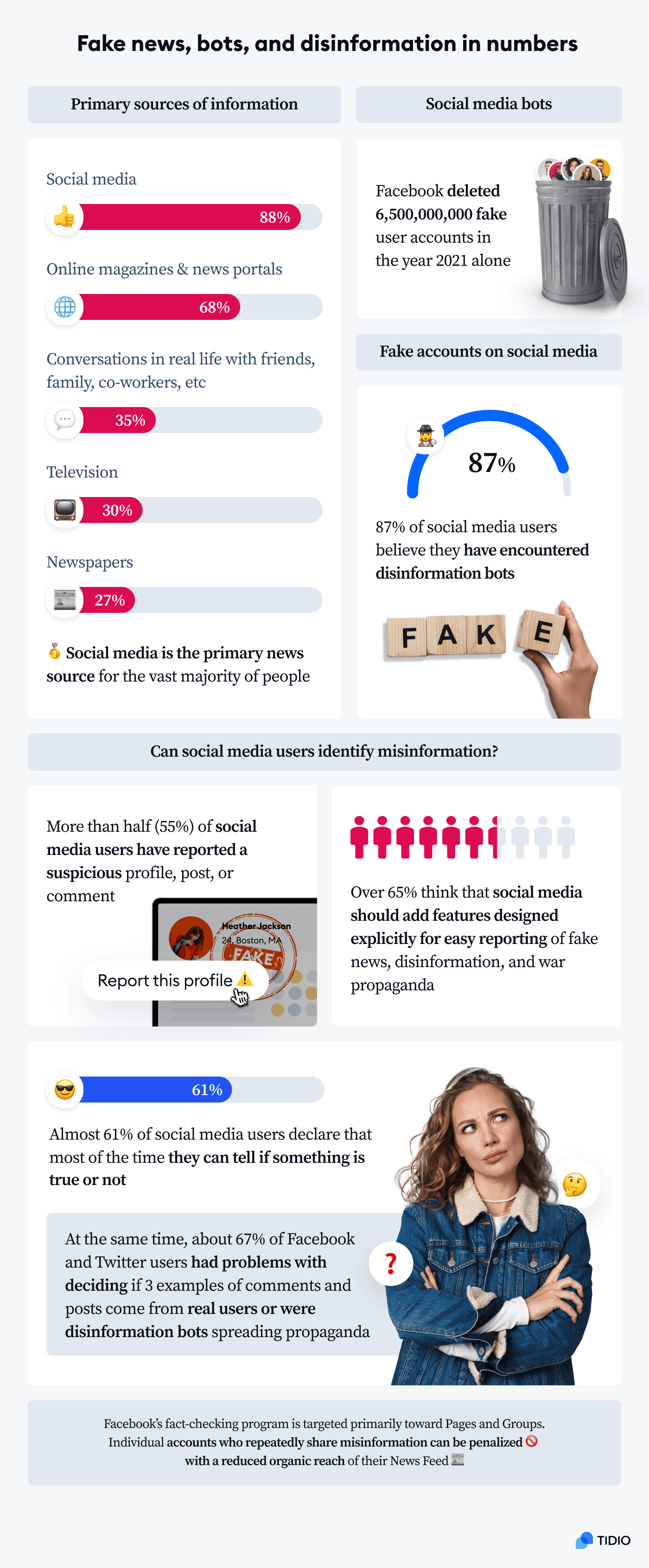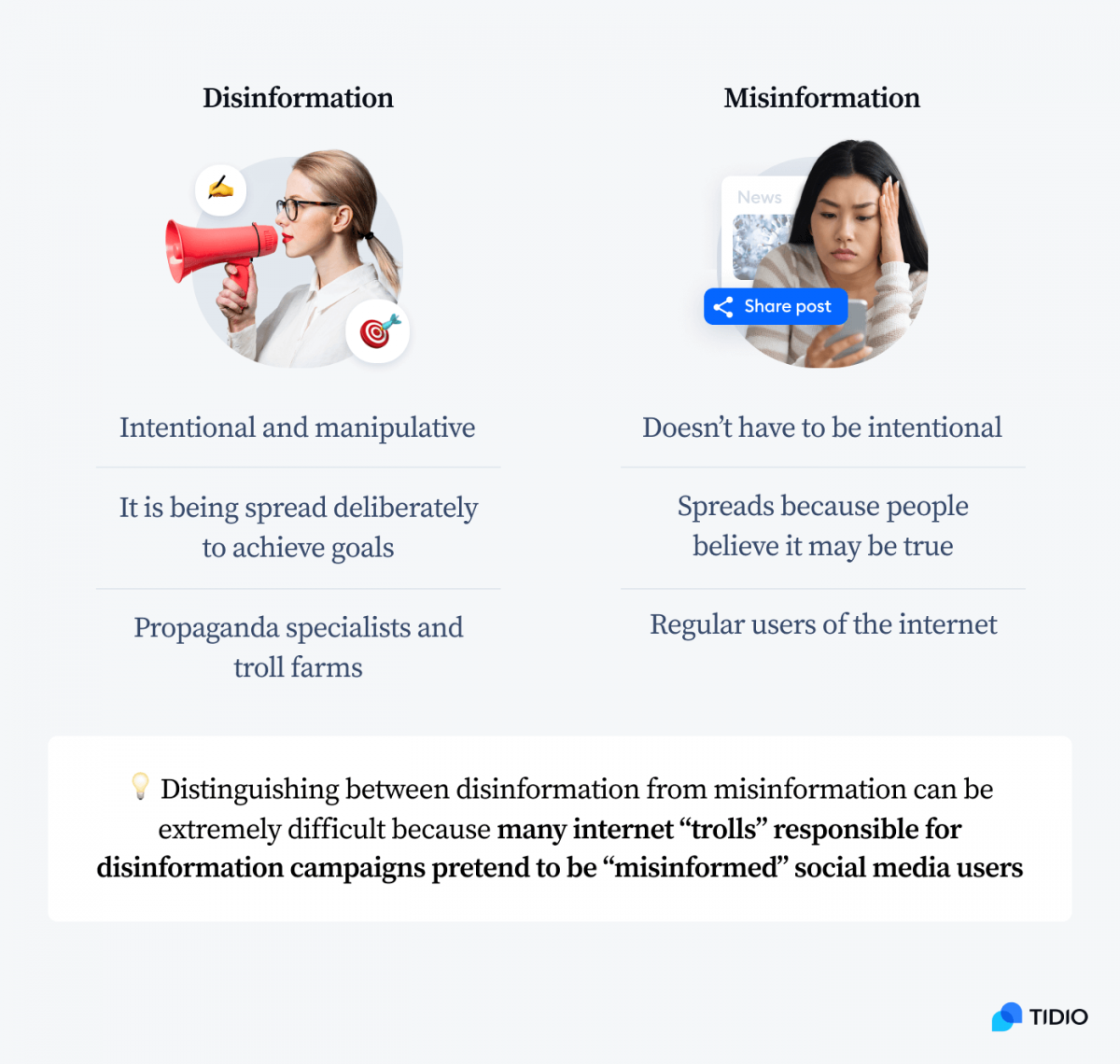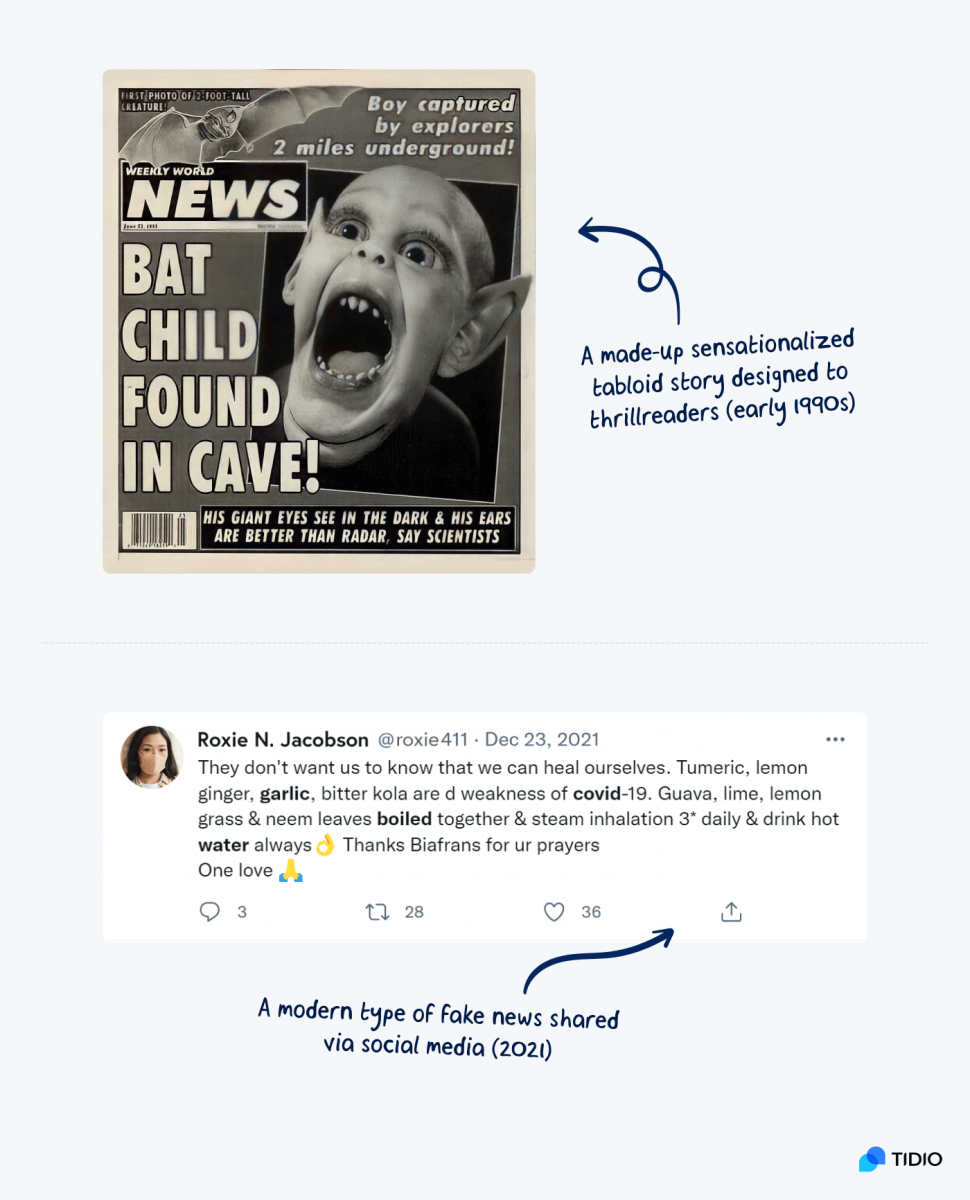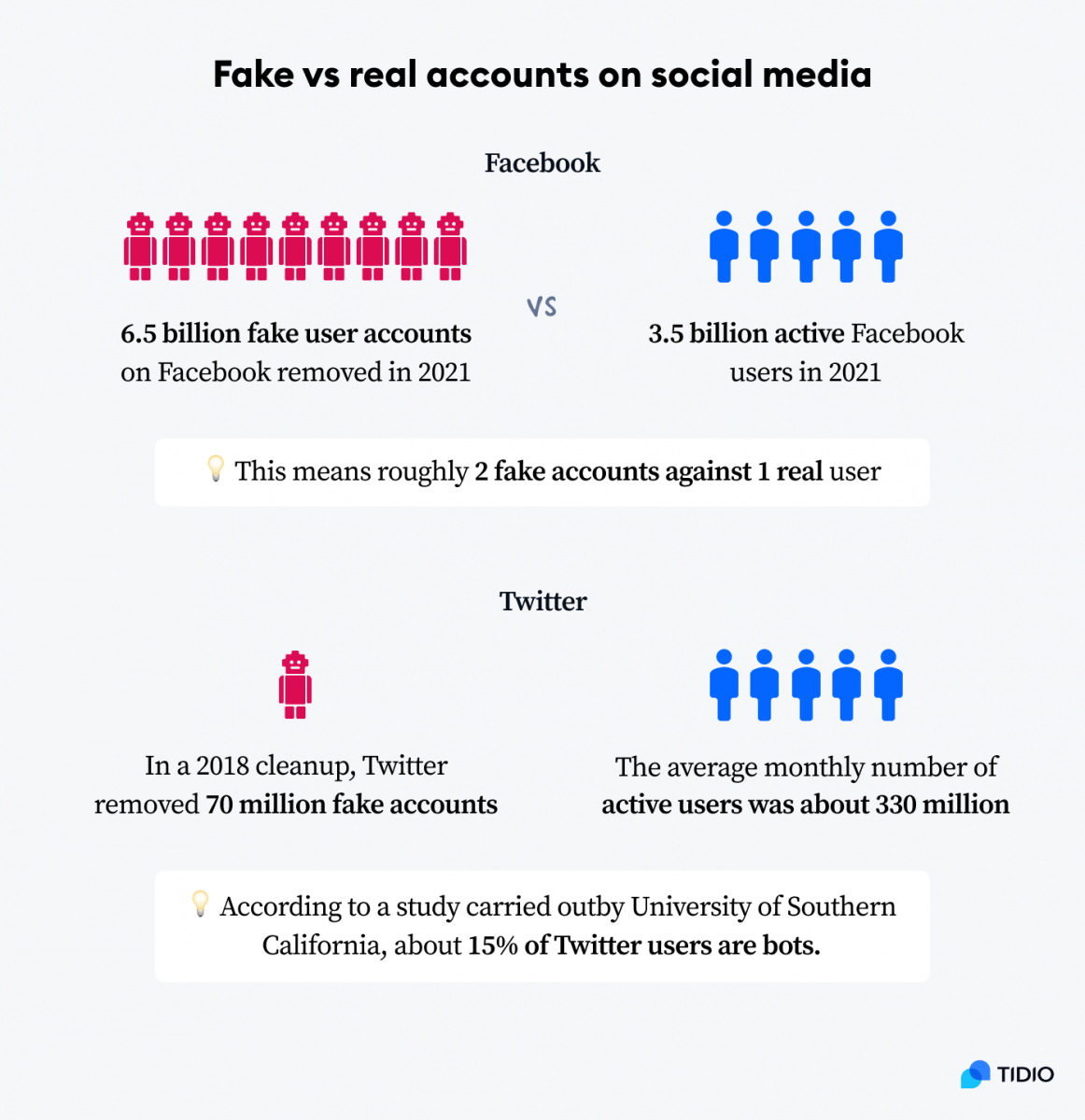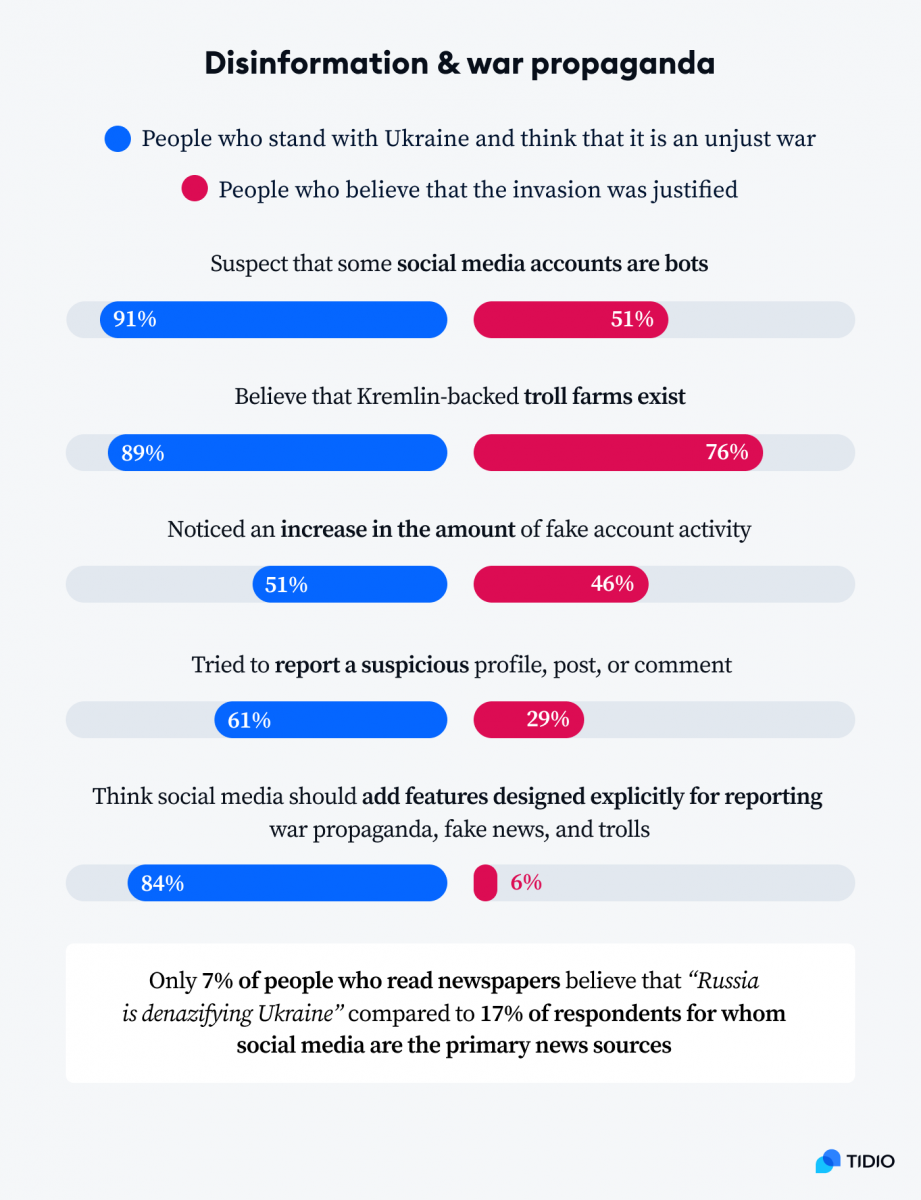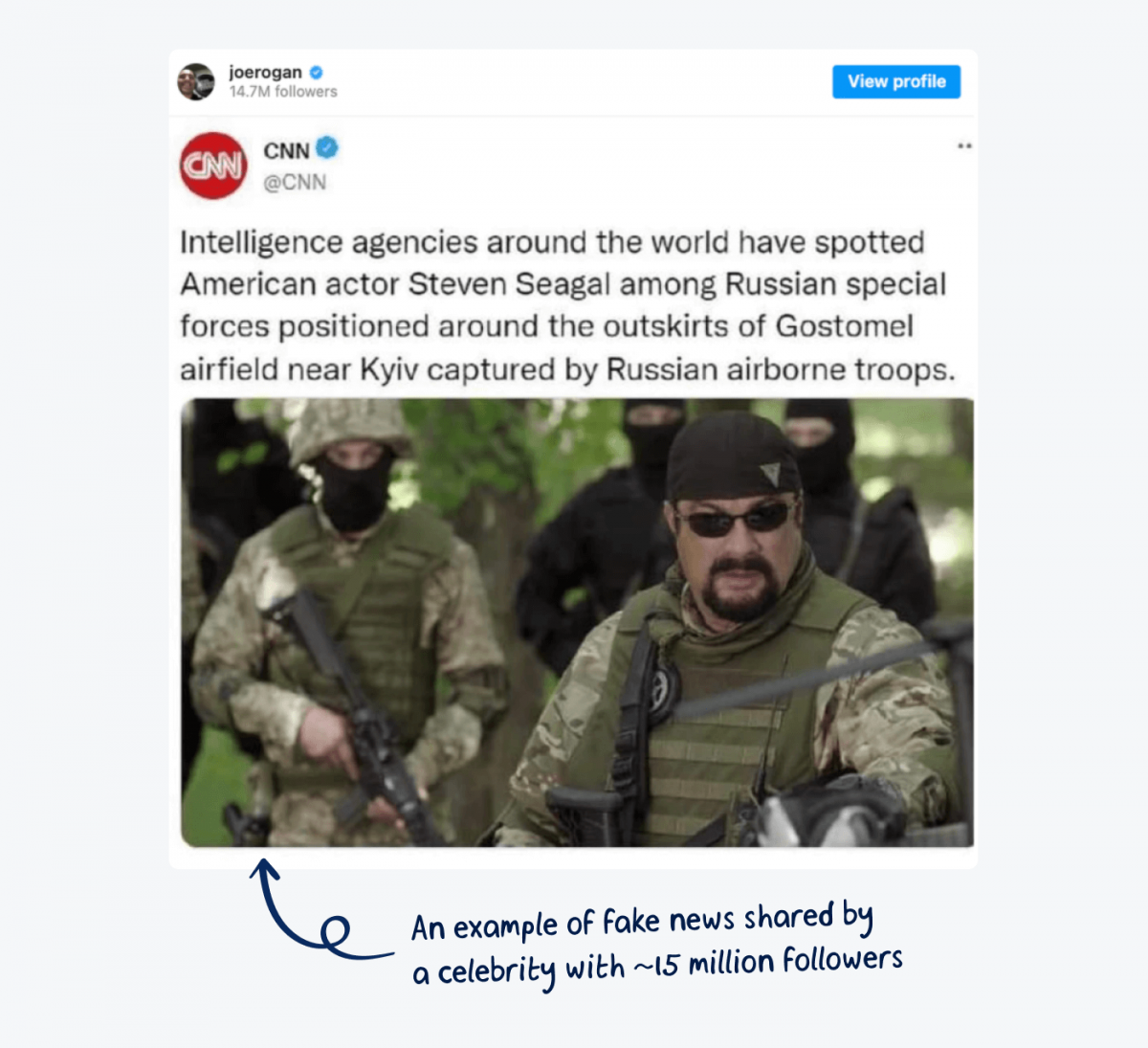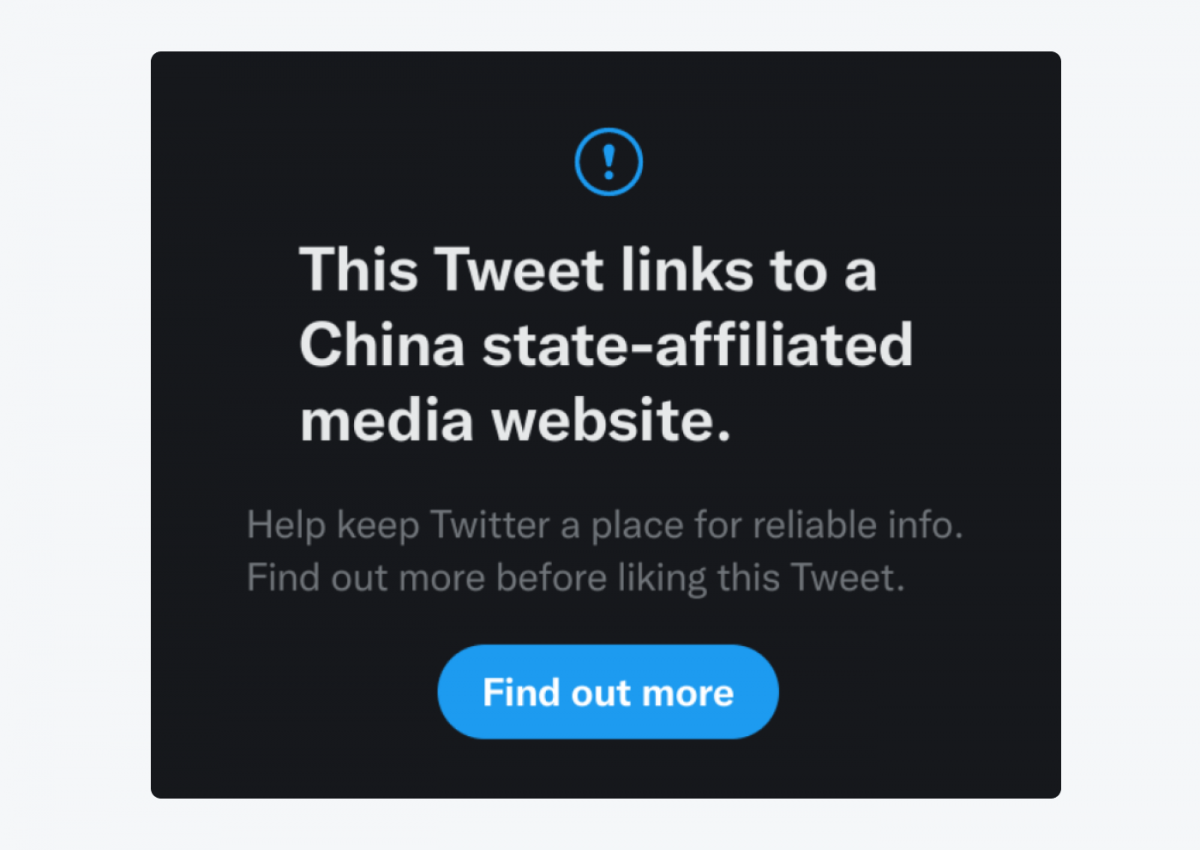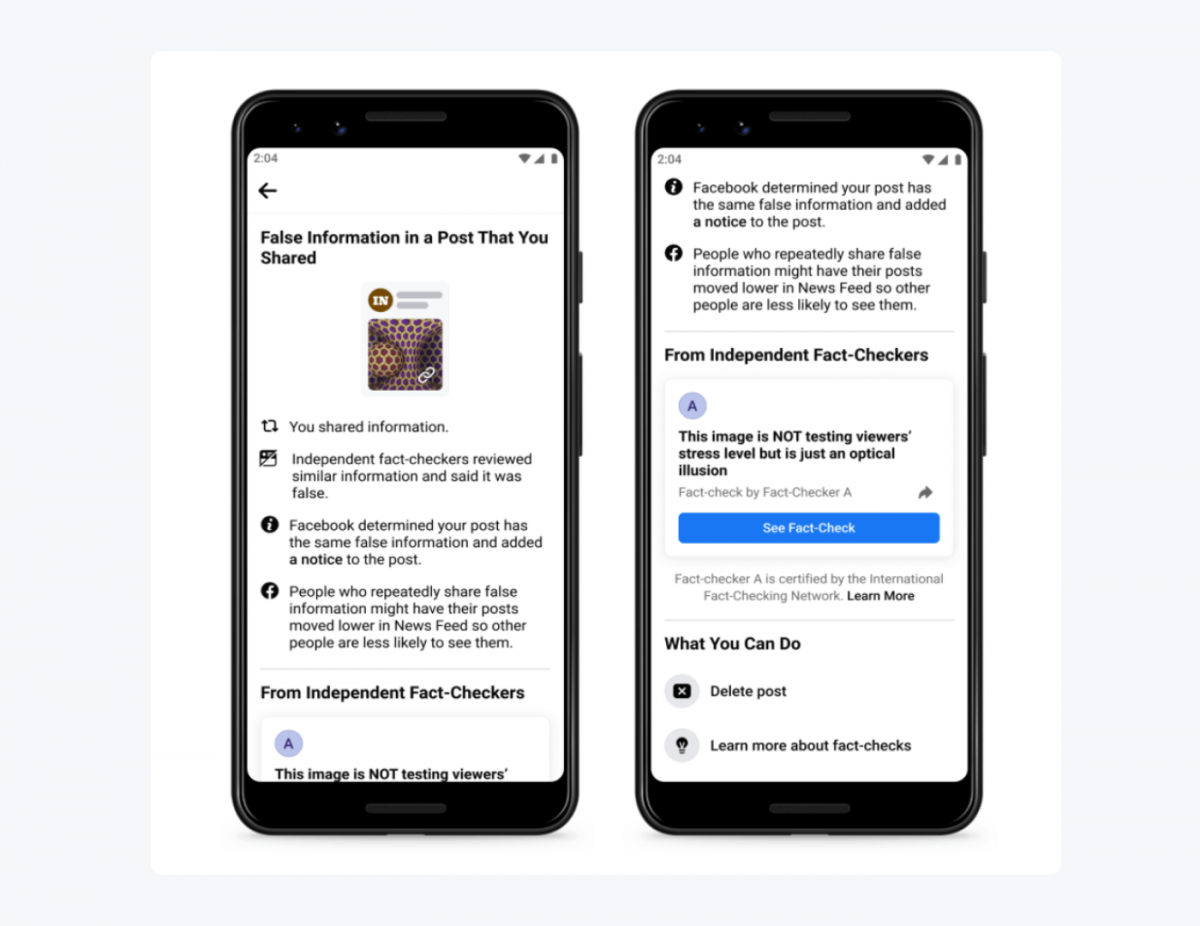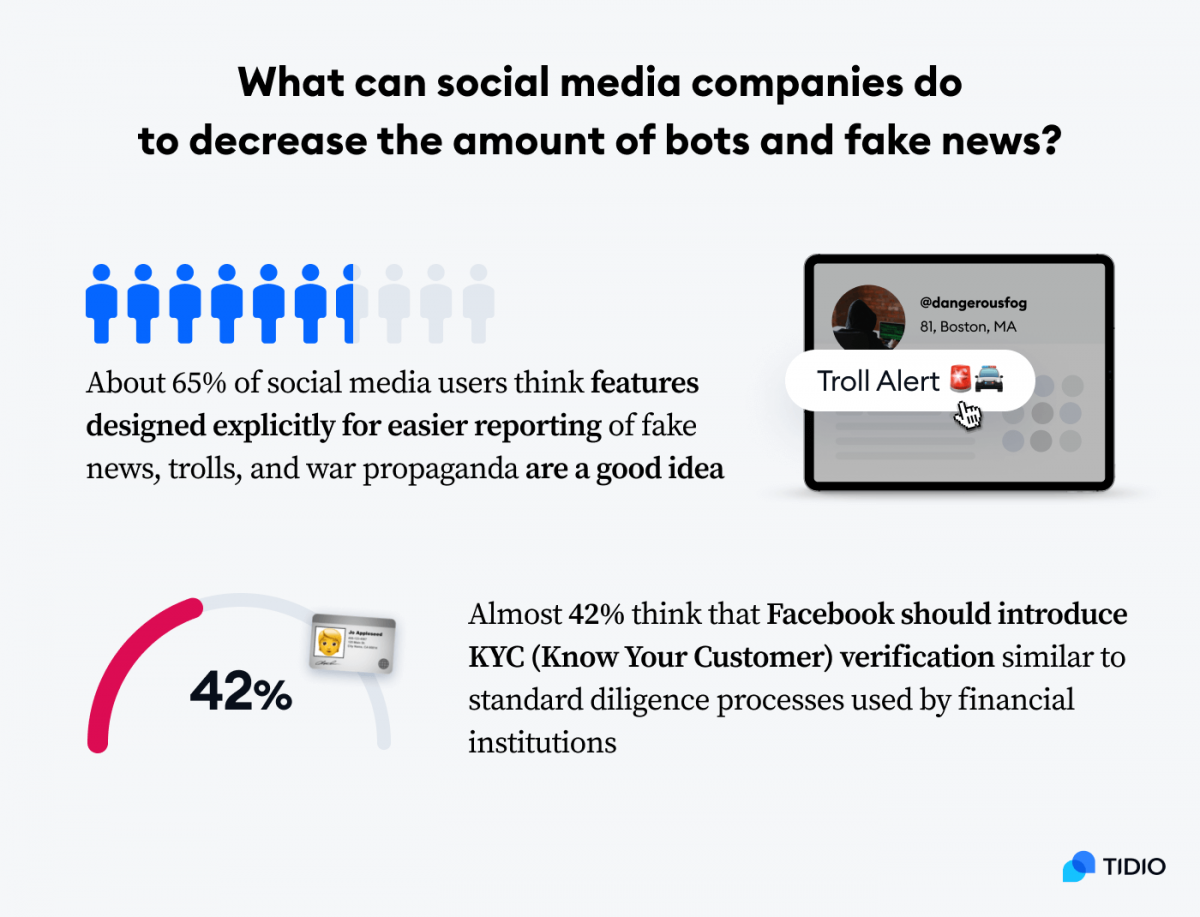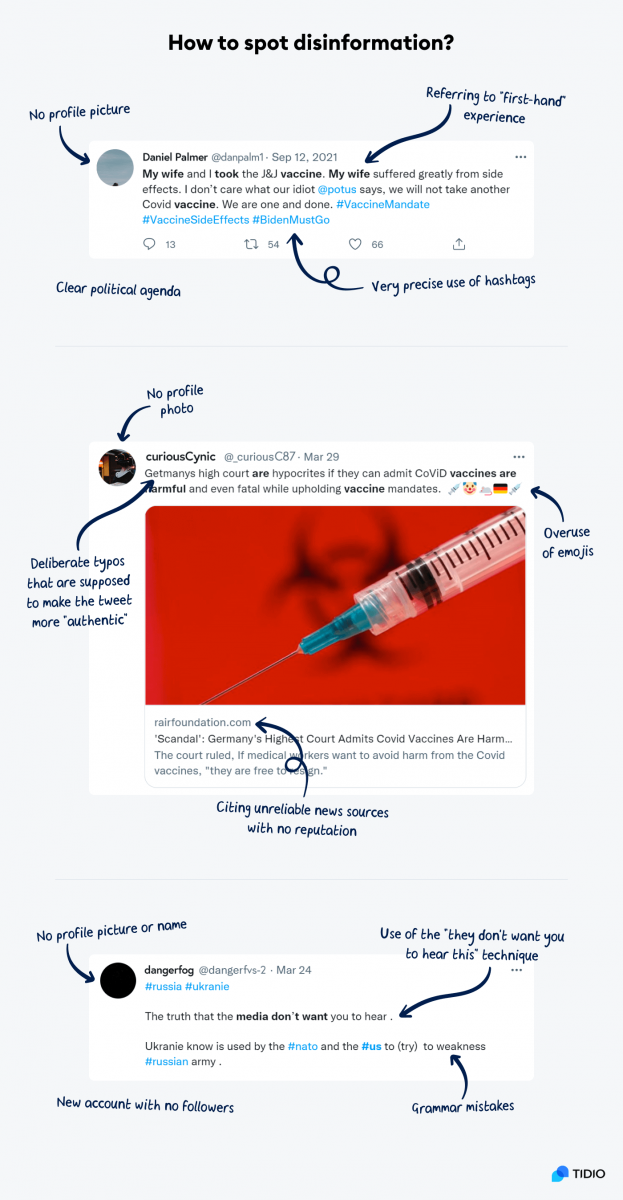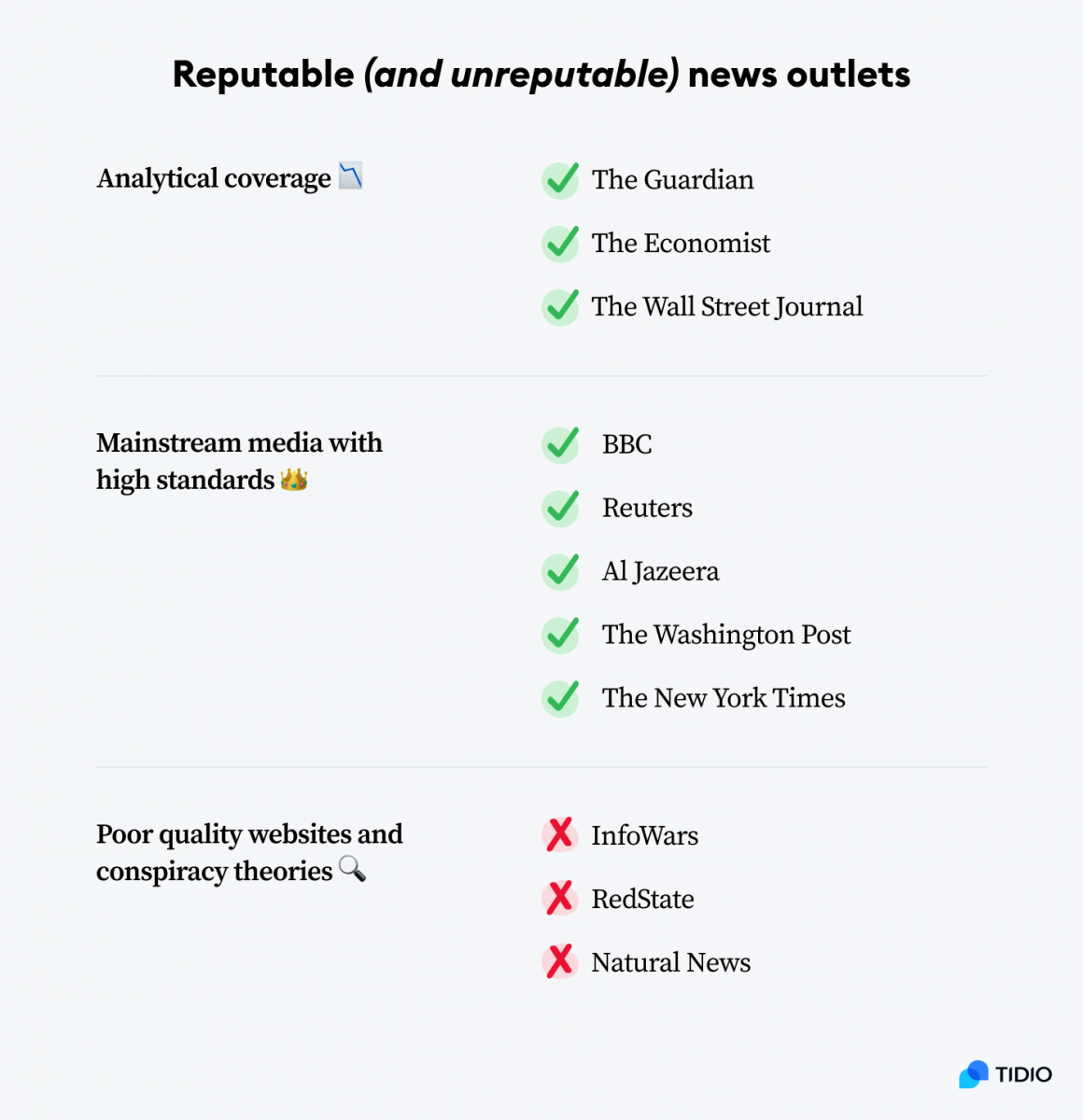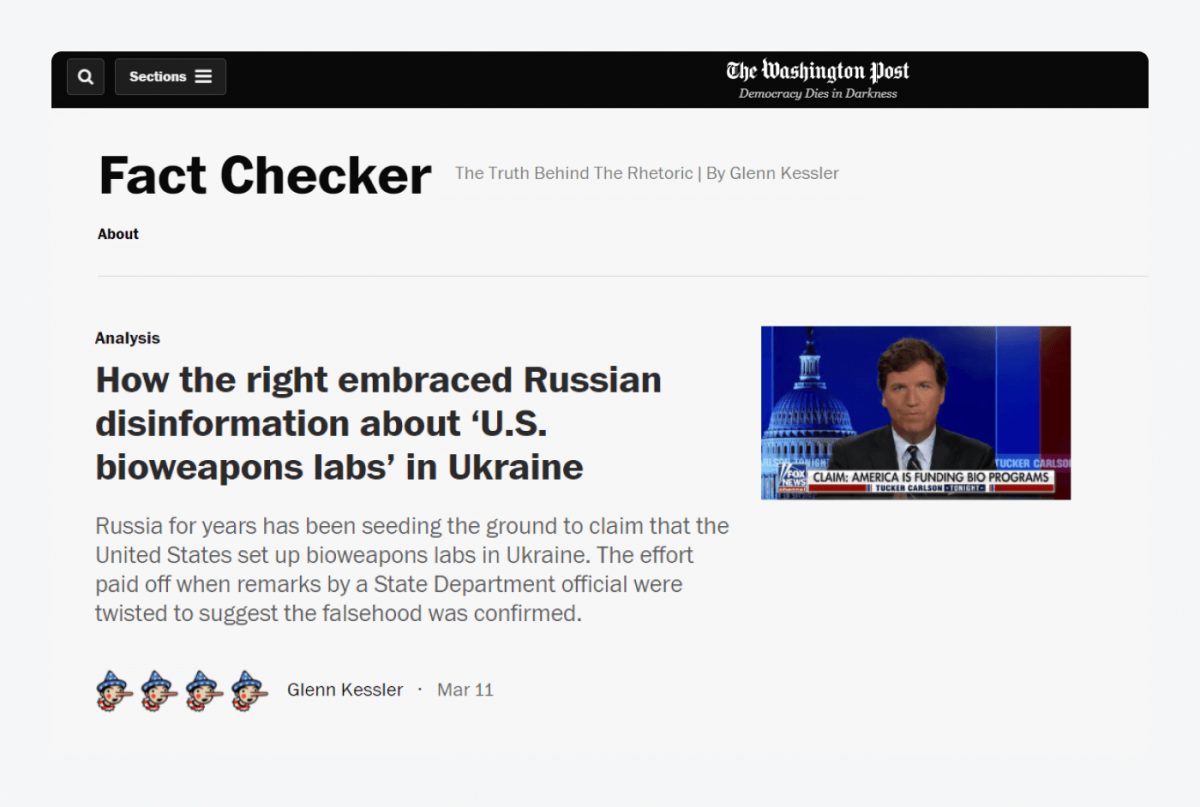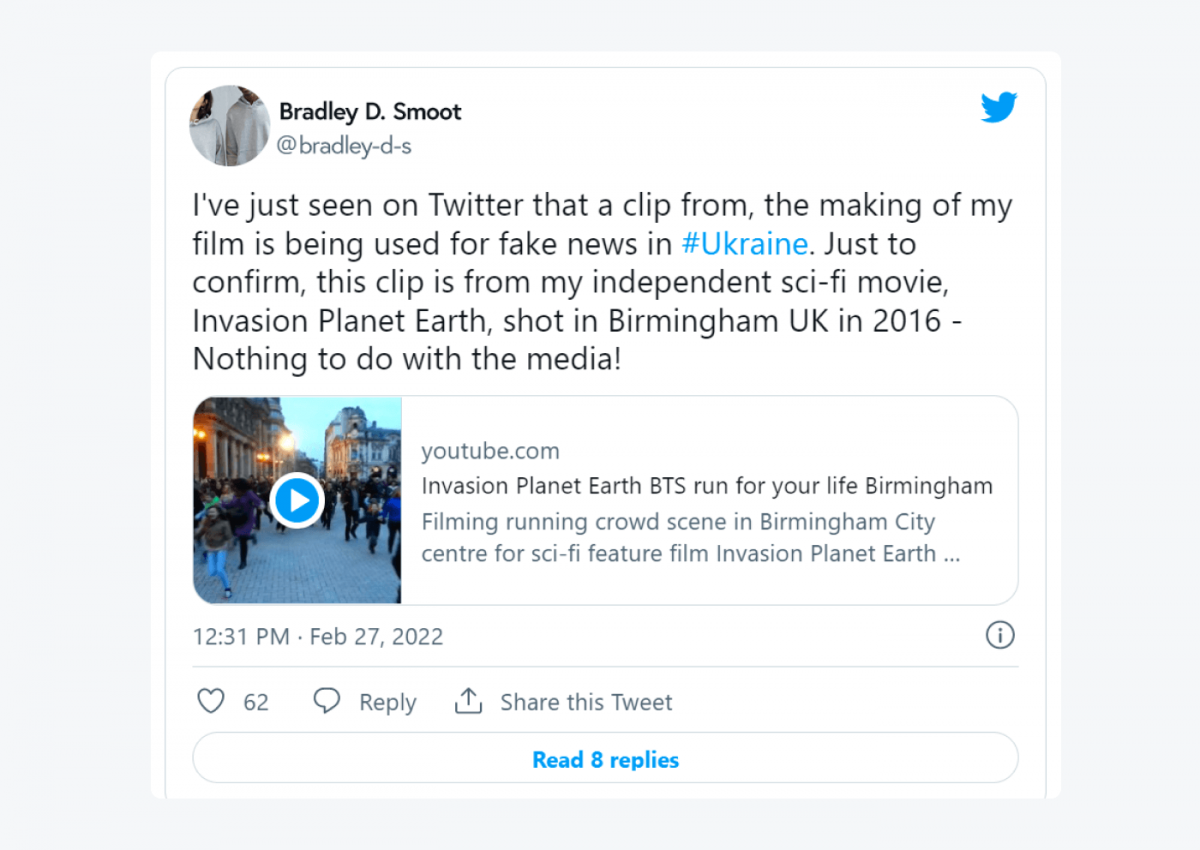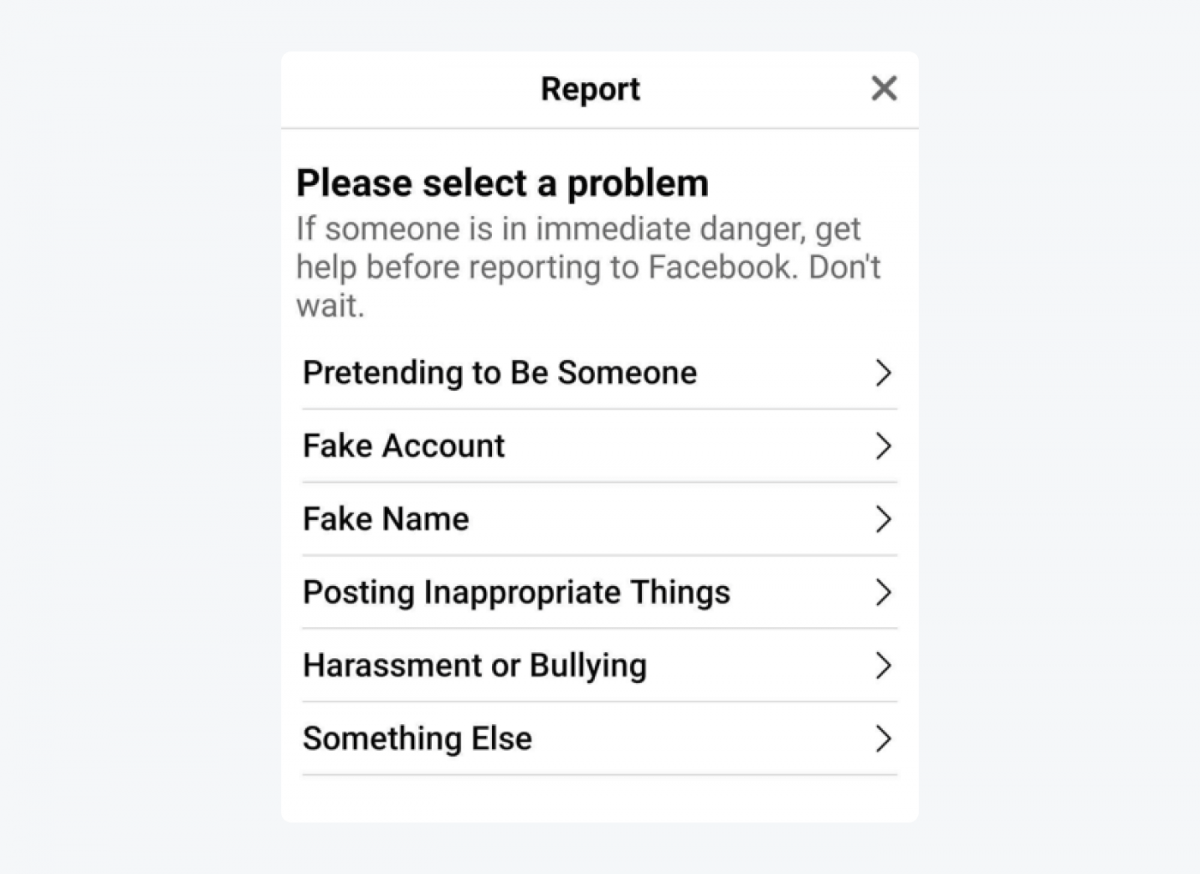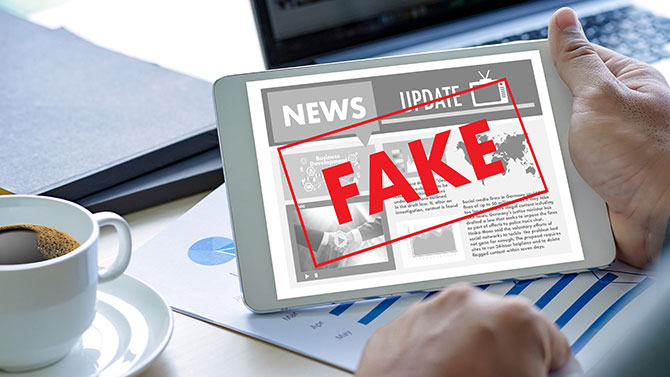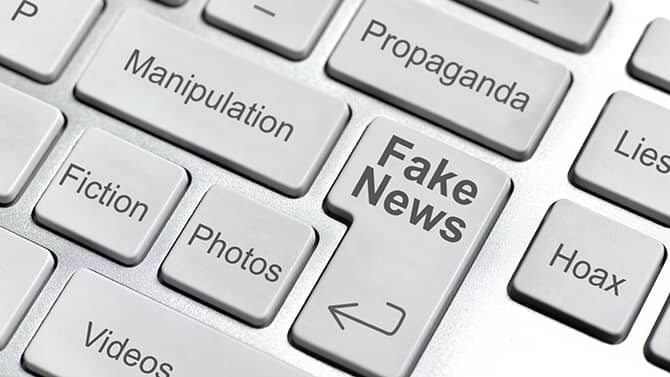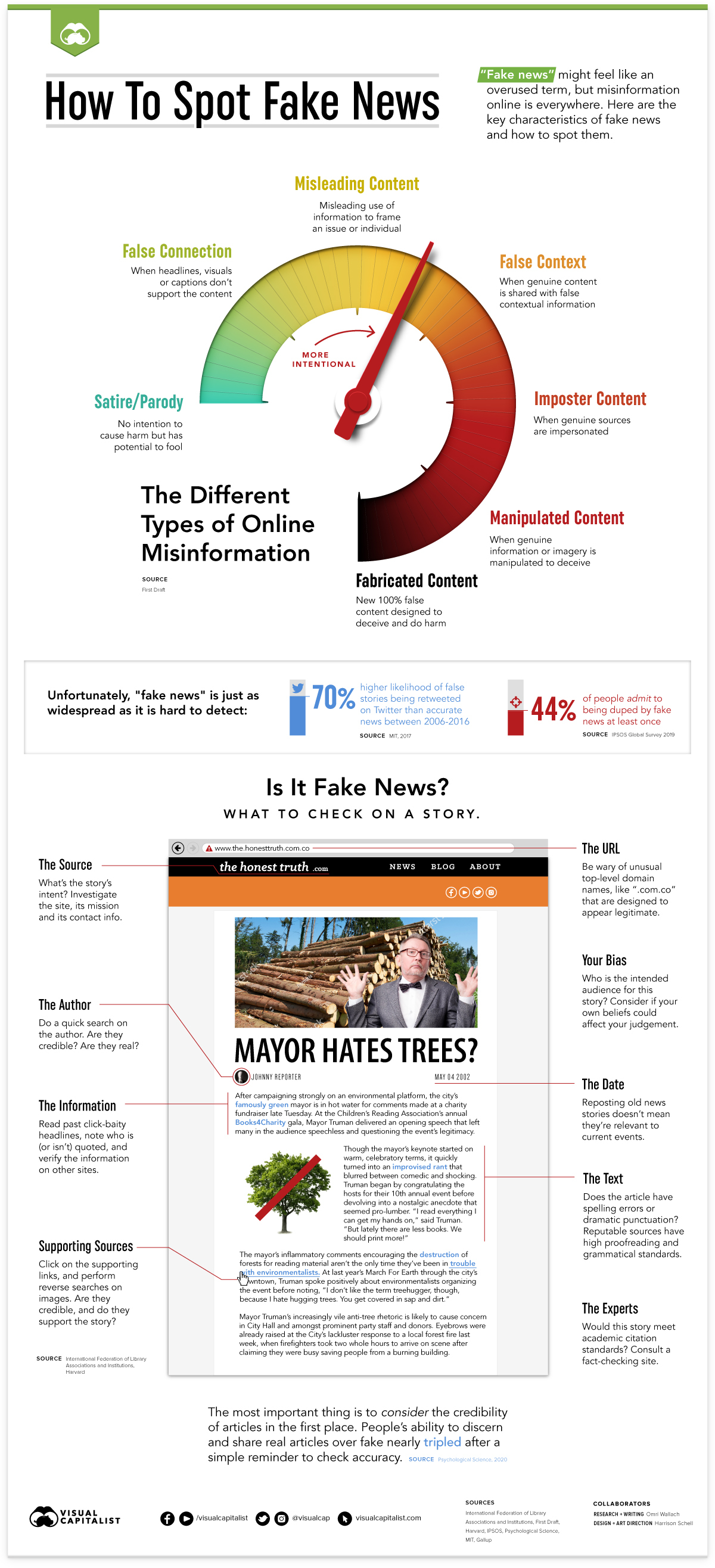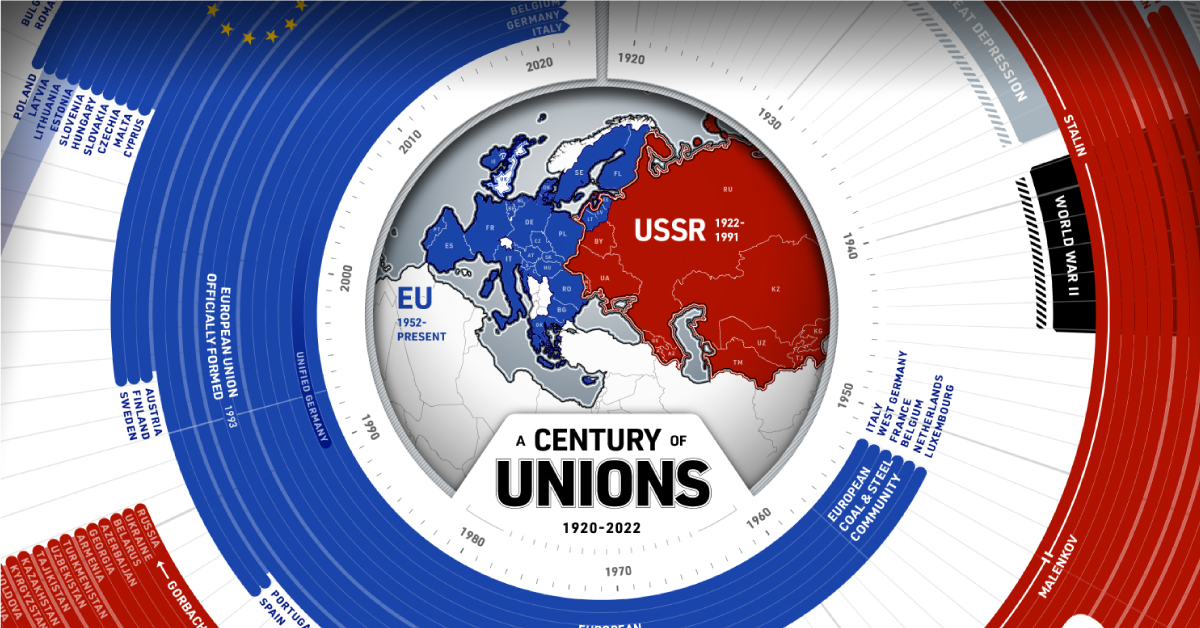How to spot fake news
How to spot fake news
Easy Ways to Spot Misinformation & Fake News in 2022
What is one problem you should keep in mind when researching information on the internet?
Not all sources are reliable.
You need to be careful about the information you find. And make sure to verify it with other sources before using it or passing it on.
When working on a paper or writing an article, we are usually alert to this issue.
But are we equally suspicious if we scroll through social media or casually surf the web on a daily basis?
Troll farms and bots posting fake news online are the major sources of disinformation related to climate change and COVID-19 vaccines. Recently, Facebook and Twitter removed thousands of fake accounts targeting Ukrainians by spreading disinformation and Kremlin propaganda.
Truth can be boring and complicated. Disinformation campaigns, on the other hand, prey on our emotions. A study by MIT confirmed that fake news spreads 6 times faster than real stories and is 70% more likely to be retweeted.
If we go online, we should always switch our brains to “fake news detector” mode.
In the article:
We carried out our own research to see how big the problem is and how people deal with fake information online.
What is disinformation?
is false or misleading information that is deliberately spread in order to deceive people. It can take the form of propaganda, rumors, or hoaxes. Disinformation can be used to influence public opinion or to divert attention from the truth.
The terms disinformation and misinformation are often used interchangeably, but they actually have slightly different meanings.
What is the difference between misinformation and disinformation?
A lot of the time, people spread misinformation because they believe it’s true. Disinformation, on the other hand, is more deliberate and intentional. It is a subset of misinformation in which the deceivers know that they are spreading lies or rumors.
Fake news is another term used to describe deliberately false or misleading information that is usually spread online.
The goals of disinformation campaigns vary, but they typically fall into one of two categories: to discredit an opponent or to influence public opinion. Disinformation can be used to cast doubt on the credibility of a person or organization, or to make it seem like an opponent’s policies are more radical than they actually are.
What is the scale of the problem?
How much of the internet is fake
There are billions of social media bots spreading misinformation. Check the infographic below to see the exact numbers for Facebook and Twitter based on their official annual reports.
Bot farms and social media play a huge role in spreading fake news and disinformation. Platforms like Twitter or Facebook allow users to share stories without verifying their sources. Anyone can share information with a large number of people with several clicks. And many social media users believe what they see online without questioning it.
Examples of fake news on social media include:
In the context of recent events in Ukraine, it is worth noting how big a role social media plays.
Where does fake news come from exactly?
Fake news can come from a variety of sources. For instance, “clickbait” websites deliberately publish sensational or exaggerated stories in order to get people to click on them. Many of these websites make money by running ads, so they have a financial incentive to publish fake news.
When it comes to social media, however, one of the biggest actors and organized groups are so-called Russian web brigades.
The use of social media and online forums by the Russian government has been well documented, and the Russian troll armies are a major part of this. These brigades are made up of paid trolls who post comments and links to pro-Russian articles and videos in order to influence public opinion.
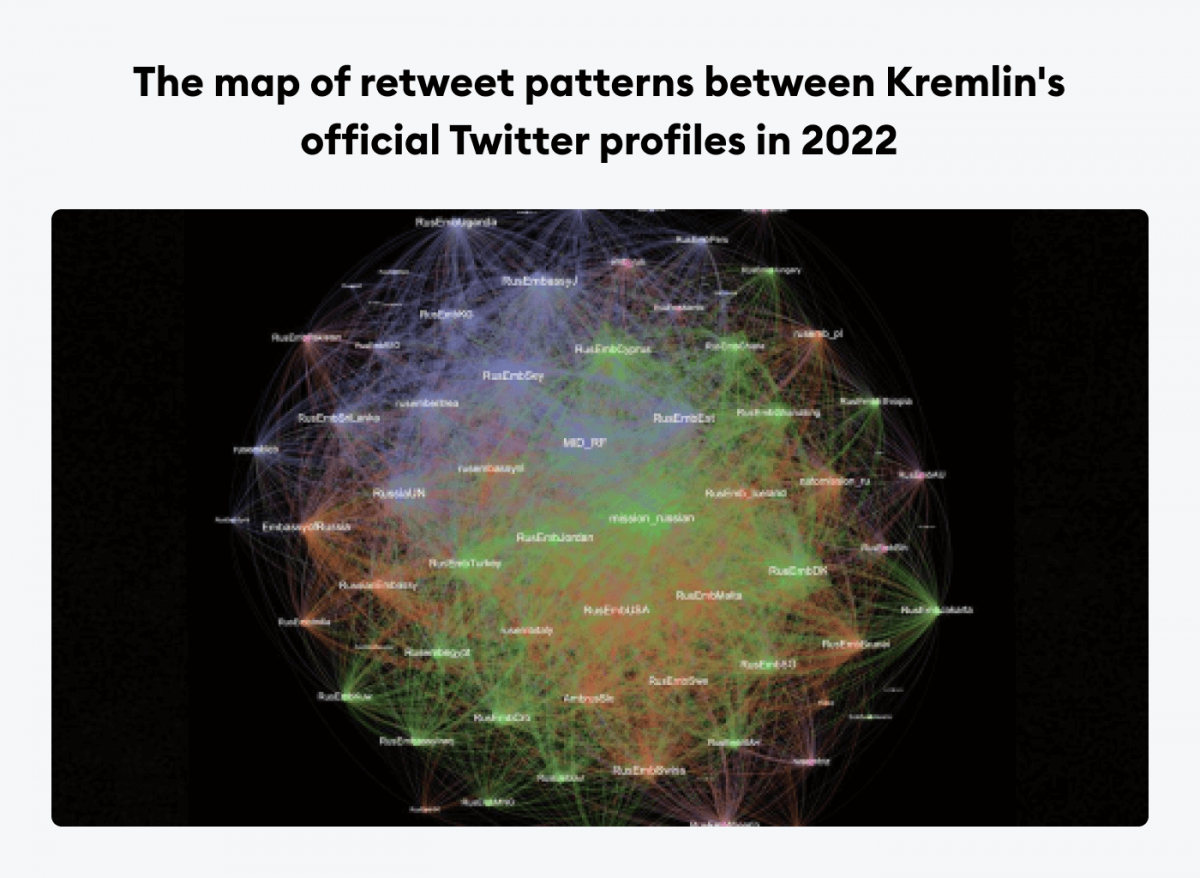
The visualization above shows how pro-Kremlin Twitter accounts mutually retweet each other’s content, including fake news about the war. This network of connections is showing only official government profiles—the very tip of the iceberg.
Who spreads fake news and why?
There are a lot of different reasons someone might spread fake news and disinformation. Some people do it for financial gain, others do it to promote their political or social agenda. Still, others do it just to cause chaos and confusion.
The last group, conspiracy theorists, is quite an interesting case. It may consist of more people than we commonly think.
A study by Toby Hopp revealed that people who lack trust in conventional media are more likely to share disinformation. There was a strong correlation between political views and the amount of fake news shared online. Social media users at the far ends of ideological extremes, both left and right-wing, shared false information more frequently than the rest.
They [conspiracy theorists & people with strong political views] commonly enforce a worldview comprised of two groups of people: those in the know (a small group of people, such as readers of the site) and “sheeple” (everyone else, and especially those who populate the dominant political sphere.
Toby Hopp
University of Colorado Boulder
For many people, having access to “secret” knowledge produces a sense of superiority. The very fact of “not following the herd” is seen as a virtue. At the same time, users who spread misinformation are not interested in fact-checking because the goal is not the truth as such. It is all about being in opposition to the commonly accepted consensus.
When it comes to the deliberate mass distribution of misinformation, most false posts and comments are spread by professional trolls. Many of them operate in Third World countries.
Recently, MIT Technology Review published a report with some wide-opening statistics. In the run-up to the 2020 election in the United States, content produced by troll farms on Facebook may have reached almost 140 million per month. Many of these fake accounts were responsible for astroturfing. Twitter bots also played a significant part in Trump’s presidential election campaign.
What is Astroturfing?
is the practice of masking the sponsors of a message or organization behind it. It is a way to influence public opinion by creating the illusion of a grassroots movement. Astroturfing can be used to promote or discredit a particular idea, person, or product. Astroturfing is often used in politics, but it can also be used in business or marketing.
Reasons why misinformation and fake news spread
Misinformation and fake news are nothing new, but they seem to be spreading like wildfire in recent years. So, what’s behind this phenomenon? Why do these false stories spread so quickly, and why do people believe them?
There are several factors at play:
How to stop fake news from spreading
There are a few things you can do to help stop the spread of fake news. First, be skeptical of everything you read online, and check the source before sharing it. If you see a story that looks too good (or bad) to be true, it probably is. Second, only share stories from reputable sources. And finally, if you see a story that you know is fake, report it to the website or social media platform where you saw it.
A great deal depends on the steps taken by tech companies and the platforms such as Facebook, Instagram, and Twitter themselves. Decreasing the number of fake news can be achieved by making it easier for users to report fake news. And by having teams of fact-checkers who can verify stories.
Facebook and Twitter are aware of the problem. Their stance on disinformation is transparent, and they introduce new features that help to fight fake news stories.
One of the problems is that social media can’t stop spreading misinformation without compromising their user privacy. On the one hand, better user verification would reduce the number of bots and fake accounts. However, only 42% of users think that ID-based user verification would be beneficial in the long run.
It should also be noted that fact-checking, at the end of the day, can be a form of censorship and limitation of free speech.
An overly aggressive approach towards removals would have a chilling effect on free speech […] I personally believe we’re better off as a society when we can have an open debate. One person’s misinfo is often another person’s deeply held belief, including perspectives that are provocative, potentially offensive, or even in some cases, include information that may not pass a fact checker’s scrutiny.
Neal Mohan
Chief Product Officer at YouTube
Additionally, some argue that “social” problems shouldn’t be addressed with “technological” solutions. Digital media literacy can be more important than algorithm updates. Educating your friends and family and taking a more critical approach to the information we see online is the best thing you can do. There are some steps you can take to make it easier.
How to identify fake news and disinformation
Sometimes it can be impossible to decide if something is disinformation or not. There are no fixed rules. It is hard to distinguish between a bot that launches a disinformation campaign and gullible users who unwittingly share it with good intentions in mind.
However, there are some giveaways that you can spot easily that should give you a hint.
If you follow the five steps below, you should be able to judge if the tweet or Facebook post you have just encountered is true or not.
Step 1: Analyze the wording and look out for red flags
The most important thing is to check sources, obviously, but the first thing is something you can do yourself and immediately.
Read the post or comment carefully and look for some common patterns.
Does it use typical phrases that are meant to boost the strength of the message and increase its credibility?
Here are some red flags and typical phrases:
Credibility is usually built by referring to a specific situation that happened to someone close or to an “insider.” Then, disinformation bots try to convince you that this is exclusive information. Probably the government/media/”they” don’t want you to know about it and are “hiding the truth.” The rest of the message is usually supposed to encourage you to share the news quickly before it disappears.
Step 2: Cross-reference the info with trustworthy sources
These days, information circulates much faster than before. If something happens to be true and newsworthy, then the chances are that established media outlets have reported it already. Try to check Google News before sharing a post or retweeting something.
Here are some reputable (and unreputable) news outlets:
It is also a good practice to see what position expert organizations are taking on a matter in question. For example, if we suspect that something related to public health and medicine is false, we should check what is the official WHO’s position.
Step 3: Visit the profile of the person who shares the information
The credibility of a post or comment can often be evaluated by visiting the user’s profile. A lot of times, spammers, trolls, or people with fake profiles will not have much information on their profile, or they may share very little content unrelated to the agenda they are pushing.
Some things you should pay attention to are:
Keep in mind that it’s easy to generate deep fakes and images that look like real people. You can use GAN software to create realistic-looking images of people. Combined with programs like Photoshop, this can be used for a variety of purposes, such as creating fake social media profiles or making believable hoaxes.
Step 4: Use additional verification tools
There are many online fact-checking tools such as the Fake News Detector developed by MIT’s McGovern Institute for Brain Research. Many of them use AI and machine learning, but are still in an early phase of development. Right now it is better to focus on verifying information through fact-checking websites.
Some websites for fact-checking, nonprofit companies, and news organizations include:
If you want to analyze some elements of suspected fake news, you can also use apps such as Google Lens. Very often, fake news is illustrated with old photos from uncredited sources. You can use reverse image search technology to find if a photo had been published before. The original context frequently turns out to be completely different.
This example of fake news was debunked by reverse image search based on individual frames of the video.
Step 5: Report posts or profiles using the appropriate policy
If you are still having trouble identifying whether you are dealing with disinformation, it is very likely that you are. It’s a good idea to signal your concern and report a post, comment, or profile that you think is suspicious.
Facebook and other social media can use the information you provide to help track down the creators of fake bogus accounts. Sometimes this also means bringing them to justice. Troll rings are eliminated and closed down all the time. So, if you see something that looks suspicious or fake, be sure to report it!
Conclusion
It can be difficult to determine whether something is fake news, but by following these simple steps, you can make an informed decision.
And remember that reporting any suspicious posts or profiles is an excellent way to fight back and combat disinformation. We can work together to keep our social networks safer and slightly more trustworthy.
Misinformation is becoming more than just an annoyance—it can have serious consequences for both democracy and world security. It’s no longer just about people sharing fake stories on social media. We need to invest in media literacy education so that people can better identify disinformation and protect themselves from it.
Sources and useful tools
Methodology
For this study about misinformation, disinformation, and fake news, we collected answers from 470 respondents on Reddit. The survey used multiple-choice questions and Likert scales.
Fair use
Has this article and our research helped you learn more about identifying fake news? Feel free to share it or quote the statistics. Just remember to mention the source and include a link to this page. Thank you!
Share this article:
Tidio’s Content Editor and Copywriter. Casimir writes about live chat and chatbots and watches over the technicalities of the publication process.
How to identify fake news
What is fake news?
Fake news refers to false or misleading information which masquerades as legitimate news. Generally, fake news falls into two categories:
Misinformation isn’t a new phenomenon – the term “fake news” was actually used in the 19 th century – but the internet and soI don’cial media have transformed how it’s created and spread. Pre-internet, people tended to receive their news from trusted media sources whose journalists were required to follow strict codes of practice. The internet enabled new ways to publish, share and consume news and information, with relatively little regulation or editorial standards. Many people now consume news from social media and other online sources – but it’s not always easy to determine which stories are credible and which are false.
Types of fake news
There are different types of fake news, depending on the motivation of those who create it. For example:
Clickbait
Sensationalism sells, and outrageous or weird stories and distorted images drive clicks and shares online. Clickbait refers to stories deliberately designed to get more website visitors and increase advertising revenue for the website owners – often at the expense of truth and accuracy.
Propaganda
This refers to false or distorted stories written to mislead audiences and promote a political agenda or biased perspective.
Poor quality journalism
Sometimes, journalists don’t have time to check all their facts before publishing, leading to genuine mistakes becoming fake news. However, trusted new sources will correct errors in their stories and be transparent with readers when they’ve got things wrong.
Misleading headlines
Sometimes a story may be broadly true, but a sensationalist or misleading headline is used to entice readers to click on it. This can lead to fake news – since usually only the headline and small snippets of the article are displayed on social media, where it can quickly spread.
Imposter content
This is when genuine news sources are impersonated with false, made-up stories to deceive or mislead audiences.
Satire or parody
Some fake news is published for entertainment value. For example, satirical stories use humor, irony, or exaggeration to joke about the news or famous people. These stories don’t attempt to mislead audiences because they aren’t meant to be taken seriously. Notable examples of satirical websites include The Onion and The Daily Mash.
High-profile politicians have been known to dismiss stories they disagree with – which may be factual and verified – as “fake news”. Because the term “fake news” is expansive and means different things to different people, it can be contested. In 2018, the British Government banned the term from official papers or documents, claiming it was too poorly defined to be meaningful. Instead, it prefers to use the terms «misinformation» and «disinformation» when describing false stories:
How does fake news work?
Fake news is often spread through fake news websites, which, in an attempt to gain credibility, often emulate authentic news sources. According to research, social media enables false claims to spread quickly – more quickly, in fact, than real news. Fake news spreads rapidly because it’s typically designed to grab attention and appeal to emotions – which is why it often features outlandish claims or stories which provoke anger or fear.
Social media feeds often prioritize content based on engagement metrics – that is, how often it’s shared and liked – rather than how accurate or well-researched it is. This approach can allow clickbait, hyperbole, and misinformation to spread widely. Social media companies are seen as platforms rather than publishers, which means they don’t have the same legal liabilities as traditional media outlets – although this may change as the political and legal landscape evolves.
Social media bots can spread fake news since they mass produce and spread articles, regardless of the credibility of their sources. Bots can create fake accounts online, which then gain followers, recognition, and authority – some of which are programmed to spread misinformation.
Trolls – internet users who deliberately try to start arguments or upset people – also play a part in spreading fake news. Sometimes they can be paid to do so for political reasons. The terms “troll farm” or “troll factory” are sometimes used in this context to refer to institutionalized groups of trolls who attempt to interfere in political decision-making.
Fake news sometimes involves the use of Deepfakes. These are fake videos created using digital software, machine learning, and face-swapping. Images are combined to create new footage which shows events or actions that never actually took place. The results can be very convincing and difficult to identify as false.
Fake news examples
Coronavirus fake news
The Covid-19 pandemic provided fertile ground for false information online, with numerous examples of fake news throughout the crisis. A persistent example of fake news in social media was the claim that 5G technology was linked to the spread of the virus – supposedly because 5G suppressed the immune system while the virus communicated through radio waves. These claims were not true and were repeatedly debunked by official sources but were still shared extensively.
US presidential election in 2016
Fake news and misinformation became a big issue during the US election in 2016, with false and misleading claims across the political spectrum. One analysis suggested that a large proportion of fake news generated in the election was created by teenagers in Macedonia, who found the more hyper-partisan stories they created, the more people clicked through and shared, and the more money they made as a result.
Boston Marathon bombing
In the wake of the Boston Marathon bombing in 2013, false claims that the bombing was an elaborate ruse plotted by the US government circulated online. In the wake of many terrorist events across the world, conspiracy theories are often rife. The notion that they are «false flag» operations – i.e., carried out by the state or a secret cabal to pin the blame on others or provide cover for other activities – is a common trope.
Kim Jong-un – the sexiest man alive?
In 2012, satirical website The Onion ran an article claiming that North Korean dictator Kim Jong-un had been voted the sexiest man alive, declaring that «the Pyongyang-bred heartthrob is every woman’s dream come true.» In an example of how satire can sometimes be misunderstood across cultures, publications in China – including the online version of China’s Communist Party newspaper – reported the claim as though it were true.
What are the dangers of fake news?
People often make important decisions – for example, how to vote in an election or what medical treatment to follow when they’re ill – based on what they read in the news. That’s why trusted news is so important. The dangers of fake news include:
How to identify fake news
You may be wondering how to identify fake news on Facebook and other social media sites? As a student, how to avoid fake news? Or how to avoid accidentally sharing misinformation online? Here are ten tips to identify misinformation, recognize fake news websites, and think before you share:
1. Check the source:
Check the web address for the page you’re looking at. Sometimes, fake news sites may have spelling errors in the URL or use less conventional domain extensions such as «.infonet» or «.offer». If you are unfamiliar with the site, look in the About Us section.
2. Check the author:
Research them to see if they are credible – for example, are they real, do they have a good reputation, are they writing about their specific area of expertise, and do they have a particular agenda? Consider what the writer’s motivation might be.
3. Check other sources:
Are other reputable news or media outlets reporting on the story? Are credible sources cited within the story? Professional global news agencies have editorial guidelines and extensive resources for fact-checking, so if they are also reporting the story, that’s a good sign.
4. Maintain a critical mindset:
A lot of fake news is cleverly written to provoke strong emotional reactions such as fear or anger. Maintain a critical mindset by asking yourself – why has this story been written? Is it promoting a particular cause or agenda? Is it trying to make me click through to another website?
5. Check the facts:
Credible news stories will include plenty of facts – data, statistics, quotes from experts, and so on. If these are missing, question why. Reports with false information often contain incorrect dates or altered timelines, so it’s a good idea to check when the article was published. Is it a current or old news story?
6. Check the comments:
Even if the article or video is legitimate, the comments below may not be. Often links or comments posted in response to content can be autogenerated by bots or people hired to put our misleading or confusing information.
7. Check your own biases:
We all have biases – could these be influencing the way you respond to the article? Social media can create echo chambers by suggesting stories that match your existing browsing habits, interests, and opinions. The more we read from diverse sources and perspectives, the more likely it is that we can draw accurate conclusions.
8. Check whether it’s a joke:
Satirical websites are popular, and sometimes it is not always clear whether a story is just a joke or parody. Check the website to see if it’s known for satire or creating funny stories.
9. Check images are authentic:
Images you see on social media could have been edited or manipulated. Possible signs include warping – where straight lines in the background now appear wavy – as well as strange shadows, jagged edges, or skin tone that looks too perfect. Bear in mind, too, that an image may be accurate but simply used in a misleading context. You can use tools such as Google’s Reverse Image Search to check where an image originates from and whether it has been altered.
10. Use a fact-checking site:
Some of the best known include:
Fake news relies on believers reposting, retweeting, or otherwise sharing false information. If you’re not sure whether an article is authentic or not, pause and think before you share. To help stay safe online, use an antivirus solution like Kaspersky Total Security, which protects you from hackers, viruses, malware, and other online threats.
Five Ways to Spot a Fake
Related Articles
Helping Students Spot Fake News and Low-Quality Sources
A recent study by Stanford University Graduate School of Education paints a very bleak picture about students’.
Lesson
A full-color poster for 6th-12th grade classrooms to anchor the six-step process of evaluating source.
Subscribe!
Turnitin blog posts, delivered straight to your inbox.
The term “fake news” is being thrown around a great deal lately. According to Google, interest in the search term rose sharply after the 2016 elections and hasn’t let up since.
The interest is more than understandable. Information literacy skills involve evaluating the credibility of a source, but social media has made it easier than ever for false stories to spread online and hoaxes have gotten even better at making themselves appear legitimate.
This is an especially big problem for students who, when researching for class, will often run across these false news stories and may believe them as fact.
So, what is an internet user to do?
The good news is that, whether you’re researching a paper or just scrolling through social media, spotting false news is fairly easy. All it takes is a bit of critical thinking and a willingness to do further research.
To that end, here are five tips to help tell the fake news from the real news:
1: Check the Source
Be sure to note any personal or political biases that may impact the reporting. Also, double check that the site is not a satire, such as The Onion, The Borowitz Report or Clickhole.
2: Search for Other Sources
As a general rule, you should always have at least two reputable sources for a story before you do anything with it, which includes putting it in a research paper or simply tweeting it. See if you can find another source to confirm the story using a search engine. If the other sources reporting it are untrustworthy, it’s probably false. However, if it’s being widely reported by reputable news sites, it’s most likely true.
3: Investigate the Article
If you’re still unsure, begin looking at the article itself. First, check the date to make sure it’s current. A lot of false news are simply old stories being presented as new events. You can search for passages from the article to see if they appear on other sites and even use Google Image Search to check and see where else the images appear. While text and images that appear elsewhere aren’t necessarily a sign of a hoax, they can be if they appear on a lot of hoax websites or on unrelated articles.
4: Visit Fact Checking Websites
If a story has been widely viewed, it most likely has been examined by one of the many fact checking websites. Visit and search for the topic on sites such as FactCheck.org, Politifact.com and Snopes.com, all of which provide robust fact checking archives for news in North America and worldwide.
5: When in Doubt, Stay Away
If you can’t independently verify an article, especially if it makes grandiose claims, it’s best to stay away from it. With legitimate news, reporters are constantly working to verify and check what others are reporting on, much the same way scientists validate the work of other scientists. If other journalists haven’t verified or debunked the claim, it’s probably best to stay away.
In the end, most false news is spread not because people are genuinely gullible, but because the story’s headline appealed to the reader’s preconceived notions and they opted to share it, often without reading the article.
If you think critically about the articles you read, including those with which you wholly agree, and you take the time to examine them for truthfulness and accuracy, you can do a great deal to spot a fake and stop the spread of false news.
How To Spot Fake News
February 10, 2021
How To Spot Fake News
“Fake news” used to be a relatively uncommon problem, but over the last decade, and especially during the COVID-19 pandemic, increasing consumption of news and articles has caused misinformation to run wild.
Far from a new concept, misinformation and cherry-picked stories have been used throughout history as a form of propaganda or information warfare. However, the rise of social media as a hub for sharing articles has spread “fake news”—false or misleading information presented as legitimate news—all over the internet.
Fueled further by increasing polarization, as well as the use of the term by former U.S. President Donald Trump to also refer to negative coverage (whether legitimate or misinformed), it seems more difficult than ever to separate trustworthy from misleading sources.
With this in mind, we combined guidance from non-profit journalism project First Draft News and the International Federation of Library Associations and Institutions (IFLA) to create this guide for understanding “fake news” and how to spot it.
The Different Types of “Fake News”
In order to spot fake news, you have to know the many forms misinformation can take.
Not all fake news is created equal, or even with the intent to deceive. Some start as opinions or jokes that become misunderstood, twisted over time, and eventually turn into misinformation. Others begin with the sole purpose of deception.
Online Misinformation From Least Intentional to Most
Despite many types of misinformation appearing to be obvious at a glance, it’s harder to discern when browsing online. In a 2019 global survey on social media by Ipsos, 44% of people admitted to being duped by fake news at least once, while others may have been duped unwittingly.
And one reason is that fake or provocative news are simply being spread further, and more maliciously. A recent study of one Facebook bot farm found close to 14 thousand bots published around 200 thousand posts each month.
How To Tell If An Article is “Fake News”
With many types of misinformation to contend with, and trust in media organizations falling in the U.S. and around the world, it might seem like you’re surrounded by “fake news,” but there are a few things you can check to be sure.
More than anything, consider that outrageous misinformation has an easier time spreading on the internet than boring real news. An MIT study found that false stories on Twitter were 70% more likely to get retweeted than accurate news.
But armed with knowledge about what “fake news” looks like, and with increased pressure on news organizations, the tide can be turned back in the favor of accurate news.
The World’s Most Searched Consumer Brands
Visualizing the UK and EU Trade Relationship
You may also like
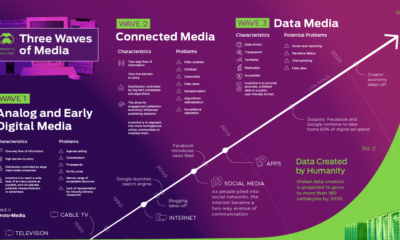
The Evolution of Media: Visualizing a Data-Driven Future
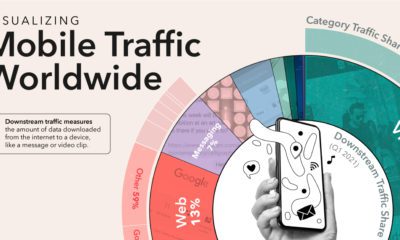
The World’s Most Used Apps, by Downstream Traffic
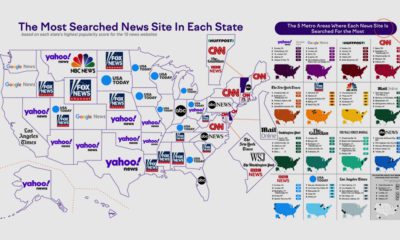
Ranked: America’s Most Searched and Visited News Sites by State
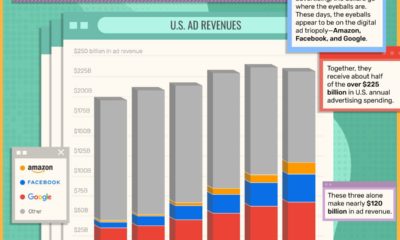
3 Companies Now Make Up 50% of U.S. Ad Revenues
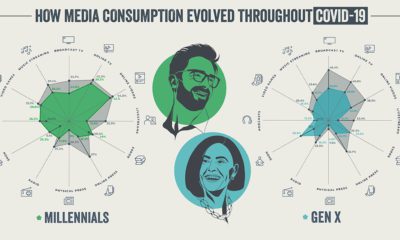
How Media Consumption Evolved Throughout COVID-19
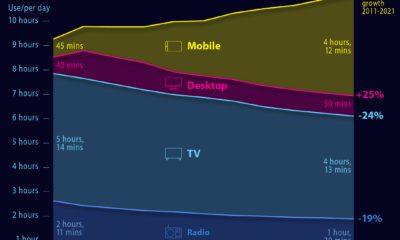
How Media Consumption Has Changed Over the Last Decade (2011-2021)
Politics
A Century of Unions in Europe (1920-2022)
This year marks 100 years since the birth of the Soviet Union. How have countries in and near Europe aligned themselves over the last century?
Timeline: A Century of Unions in Europe (1920-2022)
Of the USSR’s former republics and satellite states, many have moved on to join the European Union, and in Putin’s eyes have become more “Westernized” and further from Russian values. In fact, Ukraine recently had its candidacy status approved with the EU.
It’s now been a full century since the formation of the USSR. Much has changed since then, and this visual timeline breaks down how countries within and near Europe have aligned themselves over those 100 years.
The USSR / Soviet Union
The Soviet Union—officially titled the Union of Soviet Socialist Republics (USSR)—was formed 100 years ago in 1922 and was dissolved in 1991 almost 70 years later. At its height it was home to 15 republics, over 286 million people, and stretched from the Pacific Ocean to Ukraine, with virtual control and influence in countries as far west as East Germany.
Notable leaders characterized both the rise and fall of the USSR, starting with its establishment under Vladimir Lenin until the union’s dissolution under Mikhail Gorbachev. Latvia and Lithuania were among the first republics to make the move for sovereignty, beginning the demise of the Soviet Union.
Here’s a look at which modern day countries were a part of the USSR.
| Modern Day Country | Name Under USSR | Date Joined | Date Gained Independence |
|---|---|---|---|
| 🇬🇪 Georgia | Georgian Soviet Socialist Republic | 1922 | 1991 |
| 🇺🇦 Ukraine | Ukrainian Soviet Socialist Republic | 1922 | 1991 |
| 🇦🇲 Armenia | Armenian Soviet Socialist Republic | 1922 | 1991 |
| 🇦🇿 Azerbaijan | Azerbaijan Soviet Socialist Republic | 1922 | 1991 |
| 🇧🇾 Belarus | Byelorussian Soviet Socialist Republic | 1922 | 1991 |
| 🇷🇺 Russia | Russian Soviet Federative Socialist Republic | 1922 | 1991 |
| 🇺🇿 Uzbekistan | Uzbek Soviet Socialist Republic | 1924 | 1991 |
| 🇹🇲 Turkmenistan | Turkmen Soviet Socialist Republic | 1924 | 1991 |
| 🇹🇯 Tajikistan | Tajik Soviet Socialist Republic | 1929 | 1991 |
| 🇰🇬 Kyrgyzstan | Kirghiz Soviet Socialist Republic | 1936 | 1991 |
| 🇰🇿 Kazakhstan | Kazakh Soviet Socialist Republic | 1936 | 1991 |
| 🇱🇹 Lithuania | Lithuanian Soviet Socialist Republic | 1940 | 1990 |
| 🇪🇪 Estonia | Estonian Soviet Socialist Republic | 1940 | 1991 |
| 🇱🇻 Latvia | Latvian Soviet Socialist Republic | 1940 | 1990 |
| 🇲🇩 Moldova | Moldavian Soviet Socialist Republic | 1940 | 1991 |
Additionally, there were multiple satellite states, which were not formally joined with the USSR, but operated under intense Soviet influence.
| Modern Day Country | Country Name at the Time |
|---|---|
| 🇦🇱 Albania | People’s Republic of Albania |
| 🇵🇱 Poland | Polish People’s Republic |
| 🇧🇬 Bulgaria | People’s Republic of Bulgaria |
| 🇷🇴 Romania | Romanian People’s Republic |
| 🇨🇿 Czechia | Czechoslovak Socialist Republic |
| 🇸🇰 Slovakia | Czechoslovak Socialist Republic |
| 🇩🇪 Germany | East Germany (German Democratic Republic) |
| 🇭🇺 Hungary | Hungarian People’s Republic |
| 🇸🇮 Slovenia | Federal People’s Republic of Yugoslavia |
| 🇭🇷 Croatia | Federal People’s Republic of Yugoslavia |
| 🇷🇸 Serbia | Federal People’s Republic of Yugoslavia |
| 🇧🇦 Bosnia & Herzegovina | Federal People’s Republic of Yugoslavia |
| 🇲🇪 Montenegro | Federal People’s Republic of Yugoslavia |
| 🇲🇰 North Macedonia | Federal People’s Republic of Yugoslavia |
| 🇲🇳 Mongolia | Mongolian People’s Republic |
Today, there are still some countries that align themselves with Putin and Russia over the EU.
Belarus, sometimes called Europe’s “last dictatorship”, shares a border with both Ukraine and Russia and facilitated the entry of Russian soldiers into Ukraine. Furthermore, according to the Pentagon, Russian missiles have been launched from Belarus.
The European Union
The European Union was officially formed in 1993 and has 27 member states. Some former USSR republics are now a part of the union including Estonia, Latvia, and Lithuania. The most recent member to join was Croatia in 2013.
The EU has its roots in the European Coal & Steel Community which was formed in 1952 with Italy, France, West Germany and a few other countries comprising its first members. There are currently six candidate countries on track to join the EU — all but one were either former Soviet satellite states or formal republics:
There are many reasons countries opt to join the EU: a common currency, easier movement of goods and people between national borders, and, of course, military protection.
However, in 2020 the UK formally left the union, making it the first country in history to do so. Here’s a look at every EU member state.
| EU Member States | Year Joined | Former USSR Republic? | Former USSR Satellite State? |
|---|---|---|---|
| 🇦🇹 Austria | 1995 | No | No |
| 🇧🇪 Belgium | 1952 | No | No |
| 🇧🇬 Bulgaria | 2007 | No | Yes |
| 🇭🇷 Croatia | 2013 | No | Yes |
| 🇨🇾 Cyprus | 2004 | No | No |
| 🇨🇿 Czechia | 2004 | No | Yes |
| 🇩🇰 Denmark | 1973 | No | No |
| 🇪🇪 Estonia | 2004 | Yes | — |
| 🇫🇮 Finland | 1995 | No | No |
| 🇫🇷 France | 1952 | No | No |
| 🇩🇪 Germany | 1952 | No | Yes (East Germany) |
| 🇬🇷 Greece | 1981 | No | No |
| 🇭🇺 Hungary | 2004 | No | Yes |
| 🇮🇪 Ireland | 1973 | No | No |
| 🇮🇹 Italy | 1952 | No | No |
| 🇱🇻 Latvia | 2004 | Yes | — |
| 🇱🇹 Lithuania | 2004 | Yes | — |
| 🇱🇺 Luxembourg | 1952 | No | No |
| 🇲🇹 Malta | 2004 | No | No |
| 🇳🇱 Netherlands | 1952 | No | No |
| 🇵🇱 Poland | 2004 | No | Yes |
| 🇵🇹 Portugal | 1986 | No | No |
| 🇷🇴 Romania | 2007 | No | Yes |
| 🇸🇰 Slovakia | 2004 | No | Yes |
| 🇸🇮 Slovenia | 2004 | No | Yes |
| 🇪🇸 Spain | 1986 | No | No |
| 🇸🇪 Sweden | 1995 | No | No |
Ukraine’s Outlook
The iron curtain that was draped across Europe, which used to divide the continent politically and ideologically, has since been drawn back. But the war in Ukraine is a threat to many in Europe, and countries such as Poland have voiced fears about the spillover of conflict.
In late June, the European Council approved Ukraine’s bid for expedited candidacy to the EU, but the process will still likely be lengthy—for example, it took Croatia 10 years to formally join at the normal pace.
Beyond other needs such as military support, joining the union would allow refugees from Ukraine the freedom to migrate and work in other EU countries with ease.
How to Spot Real and Fake News
Critically Appraising Information
When Alice scrolls through her social media feed, she’s stopped in her tracks by the news that her company is about to be bought out by its biggest rival. She quickly posts a response, shares the story with her contacts, and emails it to her team so that they can discuss it later.
But then Alice has a troubling thought. What if the story wasn’t true? What if she just shared a «fake news» story? After all, she didn’t check the source.
If she has been a victim of fake news, and then added to the rumor mill herself, how will people ever trust her again?
Fortunately, there’s lots you can do to avoid making the same mistake as Alice. In this article and video, we explore how you can separate fake news from the truth.
Don’t be fooled by fake news stories!
What Is Fake News?
There are two kinds of fake news:
Stories that aren’t true. These are entirely invented stories designed to make people believe something false, to buy a certain product, or to visit a certain website.
Stories that have some truth, but aren’t 100 percent accurate. For example, a journalist quotes only part of what a politician says, giving a false impression of their meaning. Again, this can be deliberate, to convince readers of a certain viewpoint, or it can be the result of an innocent mistake. Either way, it quickly attracts an audience and can become entrenched as an «urban myth.»
To confuse matters further, there are also people who claim that factually accurate stories are fake news, just because they don’t agree with them or find them uncomfortable.
Where Does Fake News Come From?
Fake news is nothing new. But, what is new is how easy it’s become to share information – both true and false – on a massive scale.
Social media platforms allow almost anyone to publish their thoughts or share stories to the world. The trouble is, most people don’t check the source of the material that they view online before they share it, which can lead to fake news spreading quickly or even «going viral.»
At the same time, it’s become harder to identify the original source of news stories, which can make it difficult to assess their accuracy.
This has led to a flood of fake news. In fact, one study found that more than 25 percent of Americans visited a fake news website in a six-week period during the 2016 U.S. presidential election.
But, not all fake news stories are found online. Co-workers who gossip by the water cooler or while browsing print publications that fail to check their facts, for example, are also guilty of spreading misinformation, even if inadvertently.
The Impact of Fake News in the Workplace
Research shows that 59 percent of people are concerned about the effect that fake news has in the workplace, and with good reason!
For example, some people might start to believe that they no longer need evidence to back up their arguments. Others start to mistrust information all together. They stop listening to industry reports, and disengage from official workplace communication, slowing their professional growth and development. Ultimately, this can damage an organization’s learning culture.
Fake news can affect behavior, too. It encourages people to invent excuses, to dismiss others’ ideas, to exaggerate the truth, and to spread rumors. This can create divided, anxious workplaces where people are cynical and unsure of who to trust.
They might even begin to mistrust you if they believe that authority figures have lied to them, or that the information that they are working with is suspect. This can sap people of the curiosity, enthusiasm and ambition that they need to collaborate and to be successful.
Six Ways to Spot Fake News
Separating fact from fiction accurately can seem daunting. But getting to the truth is always worth the effort – even if it’s not what you want to hear! Use these six steps to weed out the truth from the lies:
1. Develop a Critical Mindset
One of the main reasons fake news is such a big issue is that it is often believable, so it’s easy to get caught out. Much fake news is also written to create «shock value,» that is, a strong instinctive reaction such as fear or anger.
Ask yourself, «Why has this story been written? Is it to persuade me of a certain viewpoint? Is it selling me a particular product? Or is it trying to get me to click through to another website? Am I being triggered?»
2. Check the Source
If you come across a story from a source that you’ve never heard of before, do some digging!
Check the web address for the page you’re reading. Spelling errors in company names, or strange-sounding extensions like «.infonet» and «.offer,» rather than «.com» or «.co.uk,» may mean that the source is suspect.
Whether or not the author or publisher is familiar, stop to consider their reputation and professional experience. Are they known for their expertise on the matter? Or do they tend to exaggerate?
Be aware that people who spread fake news and «alternative facts» sometimes create web pages, newspaper mockups, or «doctored» images that look official, but aren’t. So, if you see a suspicious post that looks like it’s from the World Health Organization (WHO), for example, check the WHO’s own site to verify that it’s really there.
Remember, even if you got the story from your best friend, this gives it no extra authority – they likely didn’t follow these steps themselves before forwarding!
Trusted online fact-checking sites like Snopes can help you to verify stories that sound too good to be true.
3. See Who Else Is Reporting the Story
Has anyone else picked up on the story? What do other sources say about it?
Avoid leaping to the conclusion that all main stream media (MSM) output is fake. This can be as unwise as following every rumor or conspiracy theory.
Professional global news agencies such as Reuters, CNN and the BBC have rigorous editorial guidelines and extensive networks of highly trained reporters, so are a good place to start. But no one is unbiased, and anyone can make a mistake, so keep looking.
Free Workbook Offer
Increase your productivity and reduce stress with this FREE workbook when you join the Club before midnight, Aug 21.

